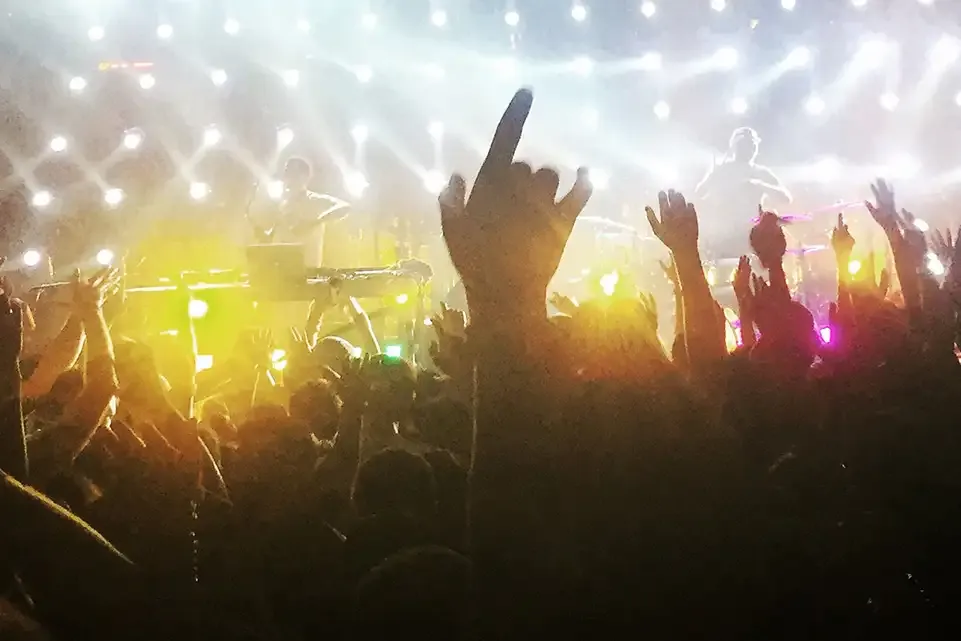Event safety & harm reduction
The principles of harm reduction accept that no matter the rigour of messaging around the individual risks and dangers of substance use, there will always be people who take or experiment with substances. As such, it is important to ensure that individual harms associated with substance use are minimised wherever possible.1
Many people who use drugs recreationally do so only on occasions, and this use is often determined by the environment they are in. Music events, such as festivals, live concerts, Electronic Music Dance Events (EMDE’s) and raves are often popular environments for substance use.2,3

The types of settings and environments people are in often influences the types of substances they consume.4 Stimulant and psychedelic recreational drugs such as MDMA and ecstasy, are among those typically consumed at music events.5
Drug use at music events
People who frequent music festivals in Australia report higher levels of illicit drug use than those of the general population. A 2011 survey of festival goers found that at least 52% had used illicit drugs once or more. Of those people, 25% had used illicit drugs in the previous month. By comparison, 42.6% of the general population had used illicit drugs at least once and 15.6% of those people had used illicit drugs in the past month.6,7
Strategies that promote zero tolerance on drug use at music events, such as significant police presence, sniffer dogs, and random drug searches are not necessarily stopping festival goers from consuming drugs. This is supported by a recent study from the National Drug and Alcohol Research Centre, which surveyed a group of people who regularly attend festivals.
Approximately 70% stated that police presence does not deter them from using illicit substances at music festivals.8 Higher rates of consumption also indicate that patrons may be at increased risk of adverse events and harm.9 It also suggests they are potentially immune to the general messaging around the risks of drug use and that more targeted harm reduction information may be more effective in this population.10
Substance use at events
The types of substance consumed, and the way in which they are taken at music events and festivals, also carry risks.
Harm reduction strategies
Harm reduction strategies at music events are numerous and diverse.
Future strategies
Pill testing is becoming increasingly common at music festivals and events around the world.
- ‘The Principles of Harm Reduction’ Harm Reduction Coalition
- NIDA for Teens, 2015, ‘Concerts and Drugs: Is there a way to reduce the Dangers’ National Institute on Drug Abuse, 2015.
- Miller, B, Holder, H, Voas, R, ‘Environmental Strategies for Prevention of Drug use and Risks in Clubs’ Journal of Substance Misuse, 14 (1), 2009.
- Smirnov A, Najman J, Hayatbakhsh R, Plotnikov M, Wells H, Legosz M & Kemp R, ‘Young Adults’ trajectories of ecstasy use:
A population Based Study’ Addictive Behaviour, Vol 38, 2013. - Miller et al, 2009, op. cit.
- Day N, Criss J, Griffiths B, Gujral SK, John-Leader F, Johnston J & Pit S, ‘Music Festivals Attendees’ illicit drug use, knowledge
and practices regarding drug content and purity: a cross sectional survey’ Harm Reduction Journal, 15 (1), 2018 - Australian Institute of Health and Welfare. National Drug Strategy Household Survey 2016: detailed findings. Canberra, 2017.
- Huges C, Moxham-Hall V, Ritter A, Weatherburn D & MacCoun R, ‘The Deterrent effects of Australian street-level
drug law enforcement on illicit drug offending at outdoor music festivals’ International Journal of Drug Policy, Vol 41, 2017. - Day et al, 2018 op. cit.
- Ibid
- ‘Drug Facts: Ecstasy’ Alcohol and Drug Foundation, 2018
- Ibid
- ‘Drug use at music festivals’ Recovery.org, 2017
- ‘Drug Facts: Amphetamines’ Alcohol and Drug Foundation, 2018
- ‘Drug Facts: Ecstasy’ Alcohol and Drug Foundation, 2018
- Makkai T, Macleod M, Vumbaca G, Hill P, Caldicott D, Noffs M, Tzanetis S, Hansen F, Report on Canberra GTM Harm Reduction Service, Harm Reduction Australia, 2018.
- Recovery.org, 2017 op. cit.
- Makkai T, Macleod M, Vumbaca G, Hill P, Caldicott D, Noffs M, Tzanetis S, Hansen F, Report on Canberra GTM Harm Reduction Service, Harm Reduction Australia, 2018.
- Miller et al, 2009 op. cit.
- Miller et al, 2009 op. cit.
- Sillins, E, Bleeker, AM, Simpson, M, Dillon, P & Copeland, J, 2013, ‘Does peer delivered information at music events reduce ecstacy and methamphetamine use at three month follow up? Findings from a quasi-experiment across three study
sites’ Journal of Addiction Prevention, Vol 1 (3), 2013. - Smirnov, A, Najman, J, Hayatbakhsh, R, Plotnikov, M, Wells, H, Legosz, M & Kemp, R, 2013, ‘Young Adults’ trajectories of ecstasy use: A population Based Study’ Addictive Behaviour, Vol 38, 2013.
- Miller et al, 2009 op. cit.
- ‘Code of Practice for running safer music festival and events’ Victorian Department of Health, 2013
- Sillins E, Bleeker AM, Simpson M, Dillon P & Copeland J, 2013, ‘Does peer-delivered information at music events reduce ecstacy and methamphetamine use at three month follow up? Findings from a quasi-experiment across three study sites’ Journal of Addiction Prevention, Vol 1 (3), 2013.
- Victorian Department of Health, 2011 op. cit.
- ‘Keeping Music Festival goers safe through Harm Reduction’ Canadian Drug Policy Coalition, 2014
- ’DanceWise’ Harm Reduction Victoria, 2018
- ‘save-a-mate’ Australian Red Cross, 2018
- St John Ambulance, 2018
- Miller et al, 2009 op. cit.
- Makkai et al, 2018 op. cit.
- Ibid

